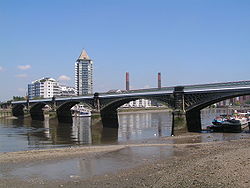Battersea Railway Bridge | |
|---|---|
 Battersea Railway Bridge from the south west | |
| Coordinates | 51°28′23″N 0°10′45″W / 51.47306°N 0.17917°W |
| Carries | Railway |
| Crosses | River Thames |
| Locale | London, England |
| Maintained by | Transport for London |
| Heritage status | Grade II* listed structure |
| Preceded by | Diamond Jubilee Footbridge (two shared piers - in construction) |
| Followed by | Battersea Bridge |
| Characteristics | |
| Design | Arch bridge |
| Total length | 230m (plus approaches) |
| Width | 10.5m |
| Longest span | 42.5m |
| Clearance below | 6m (above MHWS) |
| History | |
| Opened | 2 March 1863 |
| Statistics | |
| Daily traffic | 8 scheduled passenger trains per hour (05:45 - 23:30), plus additional unscheduled freight trains |
| Location | |
 | |
The Battersea Railway Bridge (originally called the Cremorne Bridge, after the riverside public Cremorne Gardens in Chelsea, and formerly commonly referred to as the Battersea New Bridge) is a bridge across the River Thames in London, between Battersea and Fulham. It is used by the West London Line of the London Overground from Clapham Junction to Willesden Junction. Dating from 1863, the bridge is one of the oldest crossings over the Thames in London.[1]
The bridge's completion provided a connection between the main northbound lines out of Paddington and Euston with the southbound lines of Waterloo, Victoria and Clapham Junction via the West London Extension Railway.[2] It was originally furnished with both standard gauge and broad gauge tracks; the bridge was exclusively used by freight traffic up until 1904.[2] It has been refurbished multiple times throughout its operating life. It is presently owned by Network Rail Infrastructure Ltd (who use Chelsea River Bridge as its official name ), and links Battersea to the extreme north-east part of Fulham, known as Chelsea Harbour or Imperial Wharf, a regenerated area on the south side of Chelsea Creek.